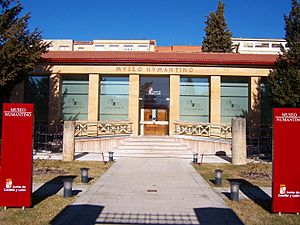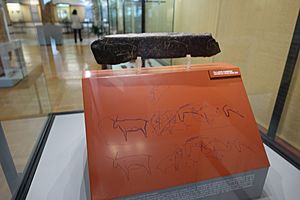Numantine Museum of Soria facts for kids
| Museo Numantino de Soria | |
 |
|
| Established | 1919 |
|---|---|
| Location | Soria, Spain |
| Visitors | 330.030 (2009) |
The Numantine Museum of Soria located in Soria, Spain, focuses on the prehistory and history of the province of Soria through art and archaeology. The name chosen for the museum, which means pertaining to Numantia, reflects the historical importance of Spain's most famous hill fort, which is a few kilometres from Soria.
The museum is the centre of a network of smaller museums in the province, such as the Museo Paleontológico de Ambrona.
The museum's displays contain much material from Numantia, but say relatively little about its siege by the Romans, which was a significant event in Spanish history. The siege is commemorated at the site itself. The museum also displays material relating to other Iron Age settlements in the province, notably Tiermes and Uxama, complementing smaller on-site museums.
Contents
History
The museum was the result of a 1919 merger of two museums in Soria, the Provincial Museum founded in the 19th century and inaugurated in 1913, and the Museo Numantino that was developed from the study of the archaeological site of Numantia, that began in the 19th century and gained importance from 1906 to 1923.
The museum building was designed by Manuel Aníbal Álvarez and funded by Ramón Benito Aceña. It was constructed on land donated by the Council and inaugurated 18 September 1919 by Alfonso XIII.
In 1932 the Museo Provincial changed its name to Museo Celtibérico. In 1941 the two museums united but maintained their independence until 1968. The integrated museums were called Museo Provincial de Soria first, then Museo de Soria and finally Museo Numantino. In 1989 it took on a total reform and the exposition was amplified up to 7.000 m2.
Building
The original building was one storey with three wings dividing two courtyards. The wings remain; however in the 1980s the main block was raised to three floors.
Conceived in chronological order, the visitor's route begins in the Lower Paleolithic. From the Bronze Age, can be highlighted weapons and tombstones, and from the Iron Age, ceramic vessels from the castros, the hill forts. From the Celtiberian stage are preserved pottery, broaches, pectorals, weapons and tools from the fields of Numancia, Uxama, Tiermes and other sites in the province. From the Roman period there are objects found in villages and cemeteries. Closes the provincial archaeological landscape the Middle Ages, from which there are preserved architectural ruins, pottery and coins.
Adaptations for people with disabilities
The route is accessible for blind and partially sighted people. With them in mind, a number of pieces and reproductions can be touched.
Collections
Stone Age
Human remains from Palaeolithic Soria are scarce, but there are impressive remains of a prey species, Palaeoloxodon antiquus, from the Torralba and Ambrona sites, where the animals were butchered about 400,000 years ago. The displays also highlight the Solutrean piece known as Placa de Villalba. Discovered in the 1980s, this represents Palaeolithic fauna. The deposits of the southwest of the province provide a lot of Neolithic objects.
Copper and Bronze Ages
The Bell Beaker culture from the Chalcolithic, and the Bronze Age are also represented with pieces belonging to the Covelda deposit and the Villar del Alba menhir.
Iron Age
The Iron Age has its representation obtained in several fields, but notably those of Numantia, Tiermes and Uxama. This period occupies the exhibition halls on the upper floors that make up the Celtiberian Section. The exhibition Celtibérica is also chronologically ordered and divided into three periods, the old, full and late with many pieces in all. It can be highlighted the notable funerary pediment with swords and antennas, broaches, pectorals or spiral plate and funerary urns. Also relevant is the ceramic part.
Roman period and later
The Roman occupation was very important due to its social and political changes. The museum displays findings from the sites of Cuevas de Soria, Santervás del Burgo and Quintanares de Rioseco also highlighting found at Numantia.
There's a Visigothic representation that comes from places that were consolidated as the towns of Numancia, Osma and Tiermes.
There are important Muslim pieces reflecting the strong Muslim presence in the province where they organised the Marca Media with capital in Medinaceli. After the Muslims left, the Christian repopulation implants Romanesque and Gothic art.
See also
 In Spanish: Museo Numantino de Soria para niños
In Spanish: Museo Numantino de Soria para niños


